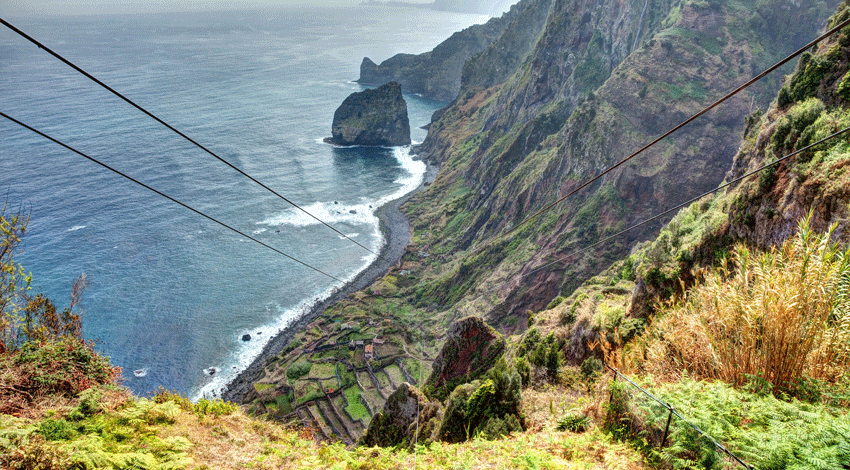The seabirds of the Madeira Islands bring visitors from around the world seeking the opportunity to observe these rare species.

Seabirds are those belonging to the order Procellariiformes, pelagic birds - birds that feed only in the open ocean, so coastal birds such as gulls or terns are excluded from this group.
The Madeira archipelago has 47 breeding species of birds, 8 of which are seabirds.
Also called tubenoses, due to their tube-like nostrils, which act as a desalinating system, these birds spend most of their life at sea and only come ashore to nest. This is why they normally choose remote and predator-free islands to breed. To avoid predators they only come ashore at night and that’s why we can only hear them or see their silhouettes when they approach their breeding colony. The best way to observe them is on the open ocean.
Seabirds are migratory, spending their non-breeding winter season at sea. Some migrate to the South Atlantic, others to Brazil and some to the eastern Atlantic around the equator.
In the archipelago, the only seabird present all year round is the Madeiran storm-petrel Oceanodroma castro with two breeding populations: a summer (April to October) and a winter population (October to April). Storm-petrels are small, weigh 35-45gm and are found far from land, feeding on pelagic crustaceans, small fish, oil droplets and plankton.
White-faced storm-petrel Pelagodroma marina has its northernmost Atlantic colony in the Selvagens Islands, returning late December. It is also known as “Jesus Christ bird” due to its way of feeding: hovering with the wings widely open and literally walking/dancing on the water (pattering above the surface). Its observation close to Madeira was very rare until Wind Birds, a local birdwatching company, started pelagic expeditions where it is now a common sighting.
On a calendar year the first returning seabirds are Manx shearwaters, Puffinus puffinus which usually return by January and can be seen from the coast. By early February some Cory’s shearwaters Calonectris borealis can be observed at sea. By March, on a coastal sea trip, the most common species observed are Cory’s shearwaters - the largest breeding seabird in the Archipelago. In lesser numbers, Manx shearwaters - a smaller shearwater with black upper sides and bill and white underparts can be observed.
From March through to October in coastal areas away from light pollution you will hear Cory’s calling with their strange owa-owa-ahh calls. They have the most unusual call out of Madeira’s seabirds and their largest colony is on Selvagens with some 30,000 pairs.
Madeira's special endemic returns from its migration by the end of February/early March; it is Zino’s Petrel, Pterodroma madeira. This species was considered extinct until 1969 and is now still threatened due to its very small population (about 70 known breeding pairs), loss of habitat and predation by rats and cats. In contrast with other seabirds species which have their nests in sea cliffs, Zino’s Petrels nest in the central mountain massif at 1700m. Wind Birds run night tours to the top of the mountains to hear and watch the silhouettes of this enigmatic bird under a starlit sky… A unique experience available between April and August!
Bulwer’s Petrels, Bulweria bulwerii, a totally black bird, known in Madeira as Alma-negra (black soul), start to visit their burrows on sea cliffs by the end of April. By then it becomes the second most common seabird off the coast, after Cory’s shearwater.
Zino’s Petrel is very similar to Fea’s Petrel Pterodroma feae, which nests on Bugio, Deserta islands and in Cape Verde. Fea's are only back from their winter migration by mid/end of May. Only a close observation at sea will allow the differentiation between these two species. Only Wind Birds have experienced ornithologists capable of pointing out the difference between these two Pterodroma species at sea.
Nowadays the most difficult tubenose to find at sea is Barolo’s shearwater, an endemic species to the Madeira Archipelago and Canary islands. We note a decline in the numbers of this species, which causes us great concern. Their normal breeding season is between December and May.
There are also some seabirds that pass through Madeira on their migration south between mid-August and mid-September, such as Great shearwaters Puffinus gravis and Manx shearwaters - the ones breeding in northern Europe, as the local ones migrate earlier(by July). Other more unusual visiting species are Sooty shearwater Puffinus griseus, Wilson’s storm-petrel Oceanites oceanicus and European storm-petrel Hydrobates pelagicus.
The rarest seabird ever observed on the ocean around Madeira was a Black-bellied storm-petrel Fregetta tropica, an Antarctic bird which was the first confirmed record for the Western Palearctic. This observation was during a Wind Birds pelagic trip.
The ocean is definitely the largest habitat on Earth…














